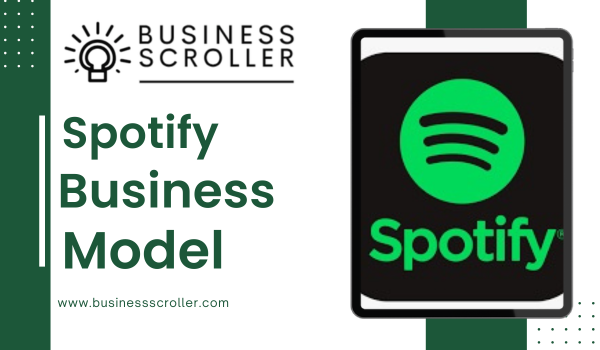When it comes to music streaming, Spotify is one of the first names that comes to mind. Launched in 2008 in Sweden, the platform has revolutionized the way people consume music across the globe. From Bollywood hits to Hollywood pop, and from indie artists to podcasts, Spotify gives listeners instant access to millions of tracks at their fingertips.
But behind this smooth user experience lies a very complex and well-designed business model. In fact, Spotify is not just a music app; it’s a global tech company with a sophisticated revenue strategy. Let’s dive deep into how Spotify actually earns money and sustains itself in a highly competitive streaming market.
The Core of Spotify’s Business Model
Spotify runs on a freemium model — a combination of free and premium services. This means it offers free access with limitations, while also encouraging users to upgrade to a paid subscription for an enhanced experience.

The company’s business strategy has three main pillars:
- Ad-supported Free Tier – Users can listen for free, but they hear ads and face limitations (like shuffle play only, limited skips).
- Premium Subscriptions – Users pay a monthly or yearly fee for an ad-free, unlimited experience.
- Partnerships & Ecosystem – Deals with telecom operators, device manufacturers, and advertisers strengthen its presence and revenue.
Key Revenue Streams of Spotify
Premium Subscriptions (Primary Revenue Source)
Spotify earns the majority of its money from paid subscriptions. As of 2025, it has more than 240 million premium subscribers globally (out of over 600 million monthly active users).
Subscribers pay a monthly fee to access:
- Ad-free music
- Unlimited skips
- Offline downloads
- High-quality audio streaming
- On-demand listening
Subscription Plans (India Example):
- Individual Plan – ₹119/month
- Duo Plan – ₹149/month (two people)
- Family Plan – ₹179/month (up to six accounts)
- Student Plan – ₹59/month
These plans vary slightly by region, but the idea is the same everywhere: give users better value at a small cost.
Revenue Share:
- Roughly 85% of Spotify’s revenue comes from premium subscriptions. This steady, recurring income is the backbone of Spotify’s business model.
Advertising Revenue (Free Users)
Spotify’s free tier is not charity — it’s a smart business tool. Free users are exposed to audio ads, video ads, banner ads, and sponsored playlists.
- Brands pay Spotify to advertise directly to targeted audiences.
- Spotify uses user data (listening habits, demographics, location) to serve highly personalized ads.
- Advertisers range from big brands (Coca-Cola, Samsung) to small businesses targeting niche listeners.
For example, if you are a college student in Delhi who listens to hip-hop, you might get an ad for a youth-focused clothing brand. This data-driven advertising increases engagement and advertiser willingness to pay.
Although ads bring less revenue compared to subscriptions, they are crucial for two reasons:
- They keep free users profitable.
- They act as a funnel to push free users into paid subscriptions.
Partnerships & Bundled Deals
Spotify often collaborates with telecom operators, internet providers, and device makers to expand its reach.
Examples include:
- Free Spotify Premium for a limited time with Jio, Vodafone, or Airtel plans in India.
- Bundles with devices like PlayStation or Samsung smartphones in global markets.
These partnerships help Spotify:
- Acquire new users at scale.
- Reduce churn (users leaving).
- Share revenue with partners while keeping customer acquisition costs low.
Podcasts & New Content Streams
Over the years, Spotify has moved beyond just music. It has invested billions into podcasts, audiobooks, and exclusive content.
- Spotify acquired Gimlet Media, Anchor, and The Ringer to boost its podcast network.
- It signed multi-million-dollar deals with popular creators (like Joe Rogan Experience).
Podcasts allow Spotify to:
- Attract users who may not primarily listen to music.
- Earn new advertising revenue (sponsored podcasts, host-read ads, programmatic ads).
- Differentiate itself from competitors like Apple Music or YouTube Music.
This diversification strengthens Spotify’s long-term revenue model.
Data & Technology Ecosystem
While not a direct “product” for users, Spotify’s data analytics capabilities are another money-making engine.
- Advertisers pay more for targeted ads, powered by Spotify’s deep data on user behavior.
- Artists and record labels use Spotify analytics to understand what fans like and where they should tour or market.
Spotify even launched Spotify for Artists, giving musicians access to valuable insights about their listeners. This improves relationships with creators and labels, while also creating future monetization opportunities.
Spotify’s Cost Structure: Where the Money Goes
To understand how Spotify earns, it’s important to also see where it spends:
- Licensing & Royalties – Nearly 70% of revenue goes to record labels, music publishers, and rights holders. Spotify does not “own” most of the music; it rents it.
- Technology & Infrastructure – Operating servers, AI recommendation engines, and app development.
- Marketing & User Acquisition – Heavy spending on promotions, discounts, and partnerships.
- Content Creation – Exclusive podcasts, licensing deals, and new formats.
This cost-heavy structure is why Spotify, despite huge revenues, has often reported slim profits or even losses.
SWOT Analysis of Spotify’s Business Model
Strengths
- Huge global user base (600M+).
- Strong brand recognition.
- Data-driven personalization.
- Diversified content (music + podcasts).
Weaknesses
- High royalty costs to record labels.
- Dependence on subscription revenue.
- Profitability challenges.
Opportunities
- Expansion in emerging markets (India, Africa).
- Growth in podcasts, audiobooks, and AI-driven content.
- Partnerships with telecom and hardware.
Threats
- Intense competition (Apple Music, Amazon Music, YouTube Music, Gaana, JioSaavn in India).
- Regulatory pressures around artist compensation.
- Consumer fatigue with subscription costs.
Future of Spotify’s Business Model
Looking ahead, Spotify aims to:
- Push more free users to premium plans.
- Strengthen podcast and audiobook monetization.
- Experiment with new tech like AI DJs and personalized playlists.
- Explore e-commerce and artist-fan direct sales.
If successful, Spotify could evolve from a music streaming platform into a full-fledged audio ecosystem.
Conclusion
Spotify’s business model is a masterclass in freemium strategy. It attracts users with free access, monetizes them through ads, and then nudges them toward paid subscriptions. By layering in partnerships, podcasts, and data-driven advertising, Spotify ensures multiple revenue streams.
In India and globally, Spotify continues to face challenges like high royalty fees and stiff competition, but its innovative approach keeps it at the forefront of the music streaming industry.
In simple terms: Spotify earns money by mixing subscriptions, ads, and partnerships — all powered by data and content. And as long as people love music and audio content, Spotify’s model is likely to stay relevant.

Shashi Kant is the Founder and Editor of BusinessScroller.com, a leading platform for business insights, finance trends, and industry analysis. With a passion for journalism and expertise in business reporting, he curates well-researched content on market strategies, startups, and corporate success stories. His vision is to provide valuable information that empowers entrepreneurs and professionals. Under his leadership, BusinessScroller.com has grown into a trusted source for in-depth articles, customer care guides, and financial expertise.


